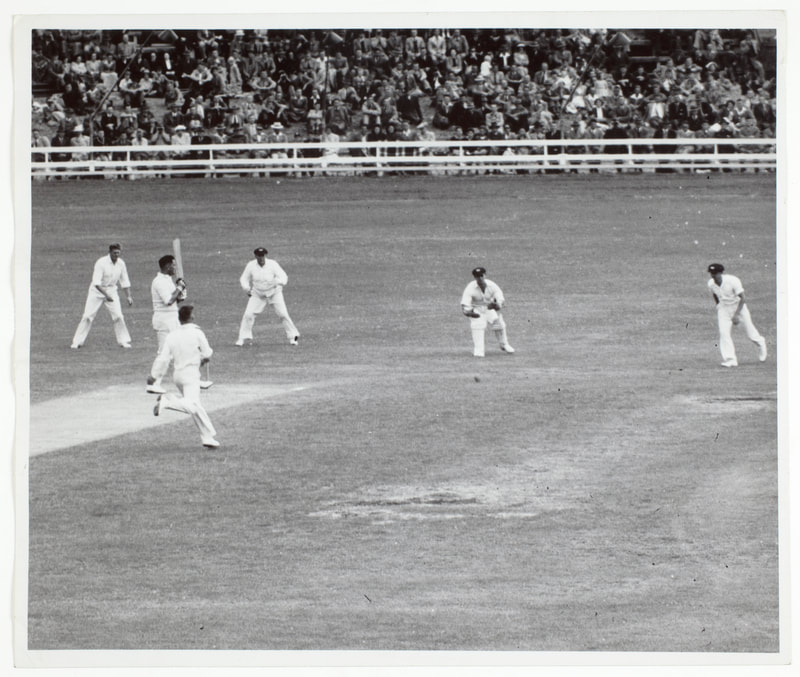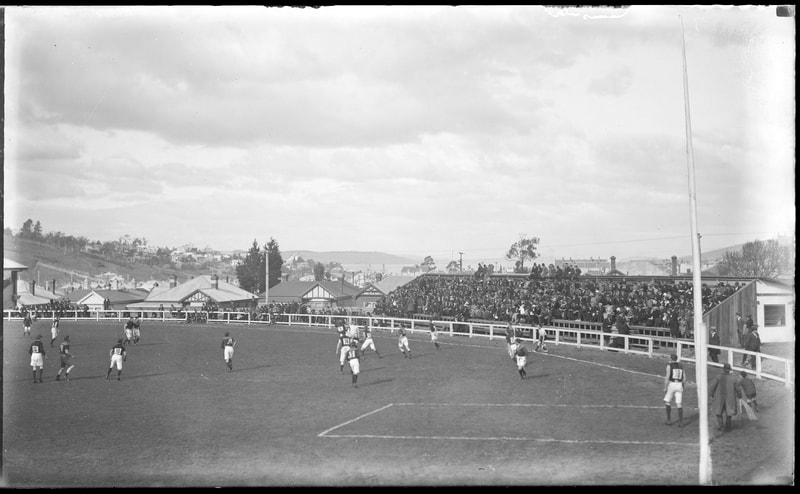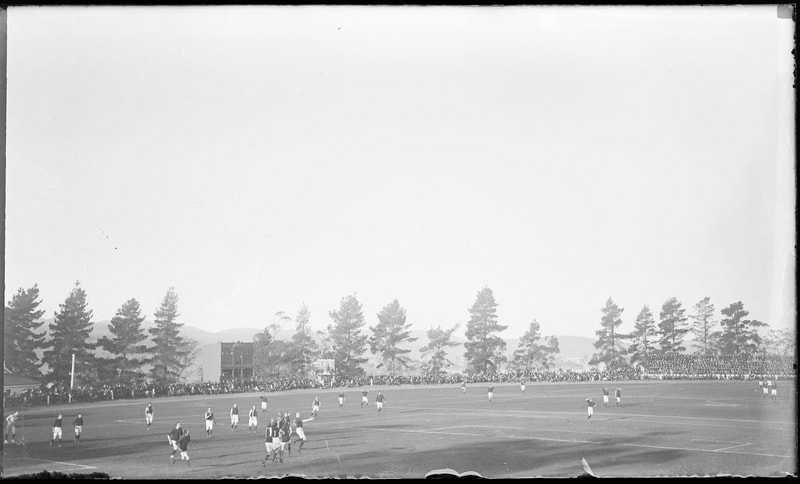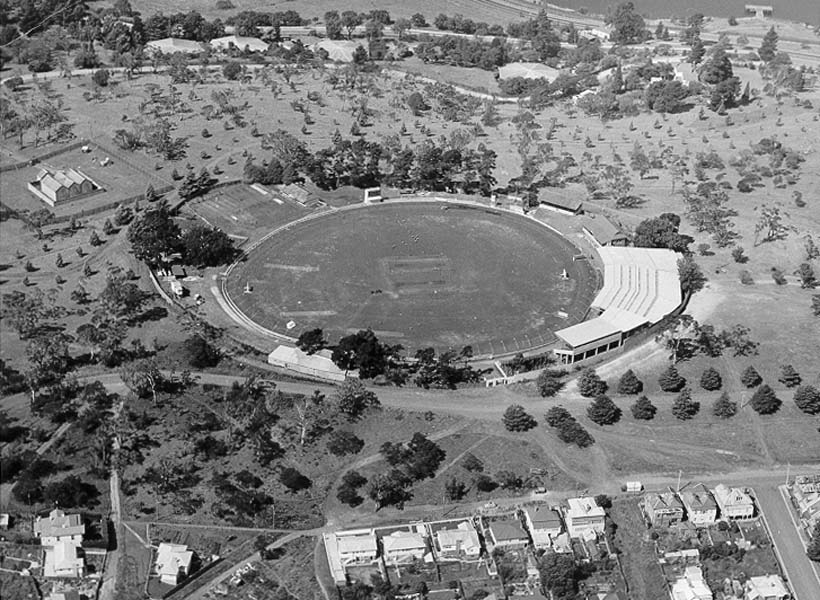The TCA ground is very picturesque: White picket fence; Old wooden grandstands; Surrounded by native bush.
1873: Southern Cricket Association leased the ground.
1882: the ground was officially opened and cricket matches were played on the ground. The official opening involved a match against a visiting MCC XI.
1881: H.C. Smith stand was built. Extended c1908 and has changed little since. A member’s pavilion; a lady’s pavilion; a box for the governor.
The 1881 section. Behind and attached to the brick building is a timber building with excellent detailing.
The 1907 section is face brick with detailing and a half-gabled corrugated iron roof.
A top deck with outside stairs was added in 1946, and by 1950 there was a players’ viewing area.
1882: The ground opened. There were also two tennis courts. There was also a skittles alley, and the wooden building on the eastern side of the ground built in 1911 which still exists was the TCA bowls club.
Cycling events have been held there, and in the 1890s winter afternoons were given over to baseball matches, and quoits was often played there in that period.
In 1902 a Japanese Sports Day involved Japanese martial arts and sumo wrestling.
1894: The small stand next to it was completed. The Ladies Stand.
When the stand was built men and women sat separately.
Football was also played at the ground for a number of years, and the STCA introduced tennis courts, skittle alleys, a bowling green and a cycling track.
1907: a new members pavilion was erected.
Memorial iron entrance gates erected in 1959.
Weatherboard Pavilion
c 1890: a pavilion not facing the present ground. A posted veranda on its front. Facing an area used for practice nets. The pavilion is on concrete piers and retaining wall, suggesting that it may have been relocated or restumped.
Weatherboard Grandstand
c1881-1890: A weatherboard tiered single story pavilion with skillion iron roof. It is a well detailed and elegant but simple pavilion with minor alterations. It is in good condition have been recently restored. The boarding is well detailed and the building is largely constructed on stumps, although the rear wall which stands on a later concrete retaining wall with toilets subsequently added underneath.
Weatherboard Shed
c1880-90: A small weatherboard pavilion with a corrugated iron gable roof dating to and located away from other pavilions. It is now used for storage and is in very poor condition. The building formerly had a hipped verandah to the front with three sets of French doors, all now missing. It is set on round timber stumps and demonstrates early construction techniques. It has been extended at the rear with a number of intrusive and poor quality sheds. Despite its deterioration the building is basically sound and requires urgent maintenance and stabilising.
A caretaker’s cottage
c1890: a small weatherboard groundkeeper’s residence with a corrugated iron hipped roof, a hip roofed verandah with timber posts and brackets and concrete flooring, and a later skillion added to the rear. There are also detached toilets at the rear. The cottage is a typical example of a plain Victorian workman's house and is related to an important group of recreation structures. The cottage is located on the northern side of the ground opposite the main grandstands and is set amongst large mature exotic trees.
The site includes significant moveable cultural heritage such as stone pitch rollers. There are a number of mature exotic trees are located within its grounds.
The ground was further developed in the 1950s when concrete stands replaced two original weatherboard stands.
Four years later new gates installed at the main entrance were named after STCA stalwart, K.E. Burn.
1935-1980: Grey hound racing was held at the ground. Minor evidence of dog kenneling quarters at the north of the ground.
The cricket ground record is 11,002 in a Tasmania v Australian XI match in 1948.
1977: Tasmania entered the Sheffield Shield and the TCA played out of Bellerive oval. Since 1977 occasional interstate matches have been played at the TCA ground when Bellerive has been unavailable.
Cricket and football have been the main sports however other sports have been played there.
1979: A crowd of 10,882 turned up on 4 January 1979 to see Tasmania win its first one-day domestic cricket trophy.
2001: AC/DC played to a crowd of 15,000.
Tenants of TCA ground: North Hobart Cricket Club; Hobart Football Club; DOSA Football Club.
One ODI: Sri Lanka Vs West Indies in 1985. The West Indies won.
Exposed to strong breezes which bowlers appreciate.
The ground is regularly used for local grade cricket in the summer, and AFL in the winter. It has both synthetic and grass nets, and an indoor bowling practice area.
No first-class cricket has been played at the TCA Ground since 1987. The ground remained the headquarters of Tasmanian cricket until the late 1980s when it was transferred to Bellerive Oval.
1873: Southern Cricket Association leased the ground.
1882: the ground was officially opened and cricket matches were played on the ground. The official opening involved a match against a visiting MCC XI.
1881: H.C. Smith stand was built. Extended c1908 and has changed little since. A member’s pavilion; a lady’s pavilion; a box for the governor.
The 1881 section. Behind and attached to the brick building is a timber building with excellent detailing.
The 1907 section is face brick with detailing and a half-gabled corrugated iron roof.
A top deck with outside stairs was added in 1946, and by 1950 there was a players’ viewing area.
1882: The ground opened. There were also two tennis courts. There was also a skittles alley, and the wooden building on the eastern side of the ground built in 1911 which still exists was the TCA bowls club.
Cycling events have been held there, and in the 1890s winter afternoons were given over to baseball matches, and quoits was often played there in that period.
In 1902 a Japanese Sports Day involved Japanese martial arts and sumo wrestling.
1894: The small stand next to it was completed. The Ladies Stand.
When the stand was built men and women sat separately.
Football was also played at the ground for a number of years, and the STCA introduced tennis courts, skittle alleys, a bowling green and a cycling track.
1907: a new members pavilion was erected.
Memorial iron entrance gates erected in 1959.
Weatherboard Pavilion
c 1890: a pavilion not facing the present ground. A posted veranda on its front. Facing an area used for practice nets. The pavilion is on concrete piers and retaining wall, suggesting that it may have been relocated or restumped.
Weatherboard Grandstand
c1881-1890: A weatherboard tiered single story pavilion with skillion iron roof. It is a well detailed and elegant but simple pavilion with minor alterations. It is in good condition have been recently restored. The boarding is well detailed and the building is largely constructed on stumps, although the rear wall which stands on a later concrete retaining wall with toilets subsequently added underneath.
Weatherboard Shed
c1880-90: A small weatherboard pavilion with a corrugated iron gable roof dating to and located away from other pavilions. It is now used for storage and is in very poor condition. The building formerly had a hipped verandah to the front with three sets of French doors, all now missing. It is set on round timber stumps and demonstrates early construction techniques. It has been extended at the rear with a number of intrusive and poor quality sheds. Despite its deterioration the building is basically sound and requires urgent maintenance and stabilising.
A caretaker’s cottage
c1890: a small weatherboard groundkeeper’s residence with a corrugated iron hipped roof, a hip roofed verandah with timber posts and brackets and concrete flooring, and a later skillion added to the rear. There are also detached toilets at the rear. The cottage is a typical example of a plain Victorian workman's house and is related to an important group of recreation structures. The cottage is located on the northern side of the ground opposite the main grandstands and is set amongst large mature exotic trees.
The site includes significant moveable cultural heritage such as stone pitch rollers. There are a number of mature exotic trees are located within its grounds.
The ground was further developed in the 1950s when concrete stands replaced two original weatherboard stands.
Four years later new gates installed at the main entrance were named after STCA stalwart, K.E. Burn.
1935-1980: Grey hound racing was held at the ground. Minor evidence of dog kenneling quarters at the north of the ground.
The cricket ground record is 11,002 in a Tasmania v Australian XI match in 1948.
1977: Tasmania entered the Sheffield Shield and the TCA played out of Bellerive oval. Since 1977 occasional interstate matches have been played at the TCA ground when Bellerive has been unavailable.
Cricket and football have been the main sports however other sports have been played there.
1979: A crowd of 10,882 turned up on 4 January 1979 to see Tasmania win its first one-day domestic cricket trophy.
2001: AC/DC played to a crowd of 15,000.
Tenants of TCA ground: North Hobart Cricket Club; Hobart Football Club; DOSA Football Club.
One ODI: Sri Lanka Vs West Indies in 1985. The West Indies won.
Exposed to strong breezes which bowlers appreciate.
The ground is regularly used for local grade cricket in the summer, and AFL in the winter. It has both synthetic and grass nets, and an indoor bowling practice area.
No first-class cricket has been played at the TCA Ground since 1987. The ground remained the headquarters of Tasmanian cricket until the late 1980s when it was transferred to Bellerive Oval.










